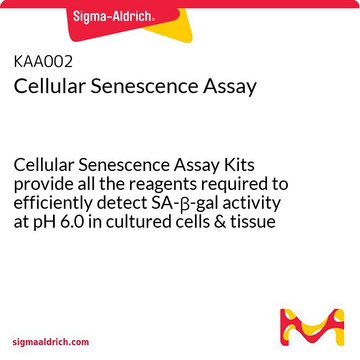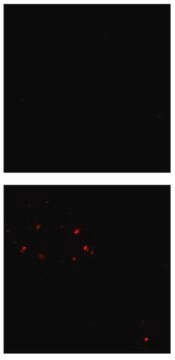MABN639
Anti-Amyloid βA4, clone 1E8 (Amino Terminus) Antibody
clone 1E8, 1 mg/mL, from mouse
Synonyme(s) :
Amyloid beta A4 protein, ABPP, APPI, APP, Alzheimer disease amyloid protein, Cerebral vascular amyloid peptide, CVAP, PreA4, Protease nexin-II, PN-II
About This Item
IP
WB
immunoprecipitation (IP): suitable
western blot: suitable
Produits recommandés
Source biologique
mouse
Niveau de qualité
Forme d'anticorps
affinity purified immunoglobulin
Type de produit anticorps
primary antibodies
Clone
1E8, monoclonal
Produit purifié par
affinity chromatography
Espèces réactives
human
Concentration
1 mg/mL
Technique(s)
immunohistochemistry: suitable
immunoprecipitation (IP): suitable
western blot: suitable
Isotype
IgG1κ
Numéro d'accès UniProt
Conditions d'expédition
wet ice
Modification post-traductionnelle de la cible
unmodified
Informations sur le gène
human ... APP(351)
Description générale
Spécificité
Immunogène
Application
Western Blotting Analysis: A representative lot was used to detect Amyloid βA4 in Western Blotting. (Wiltfang, et al. 2001; Serneels, et al. 2009; Maler, et al. 2007).
Immunoprecipitation Analysis: A representative lot was used to detect Amyloid βA4 in Immunoprecipitation. (Wiltfang, et al. 2001; Maler, et al. 2007).
Neuroscience
Neurodegenerative Diseases
Qualité
Western Blotting Analysis: A 1:1,000 dilution of this antibody detected Amyloid βA4 in human Alzheimer′s brain tissue lysate.
Description de la cible
Forme physique
Stockage et stabilité
Avoid repeated freeze / thaw cycles.
Clause de non-responsabilité
Vous ne trouvez pas le bon produit ?
Essayez notre Outil de sélection de produits.
Mention d'avertissement
Danger
Mentions de danger
Conseils de prudence
Classification des risques
Acute Tox. 3 Dermal - Acute Tox. 4 Inhalation - Acute Tox. 4 Oral - Aquatic Chronic 3
Code de la classe de stockage
6.1C - Combustible acute toxic Cat.3 / toxic compounds or compounds which causing chronic effects
Classe de danger pour l'eau (WGK)
WGK 1
Certificats d'analyse (COA)
Recherchez un Certificats d'analyse (COA) en saisissant le numéro de lot du produit. Les numéros de lot figurent sur l'étiquette du produit après les mots "Lot" ou "Batch".
Déjà en possession de ce produit ?
Retrouvez la documentation relative aux produits que vous avez récemment achetés dans la Bibliothèque de documents.
Notre équipe de scientifiques dispose d'une expérience dans tous les secteurs de la recherche, notamment en sciences de la vie, science des matériaux, synthèse chimique, chromatographie, analyse et dans de nombreux autres domaines..
Contacter notre Service technique








